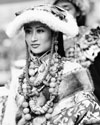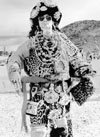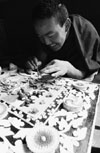| |
 |
| |
Population and Ethnic Groups |
|
|
 |
| |
Population and Population Density
The Tibet Autonomous Region has the smallest population and is the
most sparsely populated among China's provinces, municipalities directly
under the Central Government and autonomous regions. Between the 7th
century and the Qing Dynasty (1644-1911), the population fell by 8
million since monks and nuns were excluded from procreative activities.
There was further shrinkage of 800,000 from the Qing Dynasty to 1950.
According to statistics in 1951, when Tibet was liberated peacefully,
the region's population stood at 1.15 million, with mortality rate
of 28 per thousand, an infant mortality rate of 430 per thousand and
average life-expectancy of 35.5 years. During the national census
in 1953, direct population registration was not conducted in Tibet
and Qamdo and the 14th Dalai Lama-led local government estimated and
reported to the Central Government a population of 1.275 million in
Tibet.
 In
1990, the Tibet Autonomous Region's population totaled 2.1805 million
(a net increase of 1.1805 million over 1950). Population density was
less than two people per square km. In 1998, Tibet had a total population
of 2.4539 million, with 50,700 new born and 17,900 deaths. The birth
rate in the year stood at 23.7 per thousand and mortality rate at
6.9 per thousand, leaving a natural population growth of 16.2 per
thousand. As for farming and herding population, the birth rate was
22.08 per thousand and mortality rate 5.93 per thousand, with a natural
growth rate of 16.15 per thousand. There were 514,200 married women
in Tibet, with the rate of the third or above births being 36.29 per
thousand. In
1990, the Tibet Autonomous Region's population totaled 2.1805 million
(a net increase of 1.1805 million over 1950). Population density was
less than two people per square km. In 1998, Tibet had a total population
of 2.4539 million, with 50,700 new born and 17,900 deaths. The birth
rate in the year stood at 23.7 per thousand and mortality rate at
6.9 per thousand, leaving a natural population growth of 16.2 per
thousand. As for farming and herding population, the birth rate was
22.08 per thousand and mortality rate 5.93 per thousand, with a natural
growth rate of 16.15 per thousand. There were 514,200 married women
in Tibet, with the rate of the third or above births being 36.29 per
thousand.
 By
the end of 2001, the Tibet Autonomous Region had a population of 2.63
million, of which 92.2 percent were Tibetans, 5.9 percent were Han
people, while other ethnic peoples accounted for 1.9 percent. The
average population density stood at 2.03 people per square km, equaling
one-60th of the national average. Population distribution in Tibet
is uneven, with the majority of residents living in the southern and
eastern parts. The middle reaches of the Yarlung Zangbo River and
the valleys of its main tributaries---Lhasa and Nyangqu Rivers---are
the most densely populated areas, with more than 10 people per square
km on average. The Lhasa Plain, the plains at the middle and lower
reaches of the Nyangqu River and the Zetang Plain have about 50 residents
per square km, and there are more than 100 people per square km in
the vicinity of the Chengguan District in Lhasa. The next most densely
populated areas are the upstream section on the middle reaches of
the Yarlung Zangbo River, upper reaches of the Lhasa River and the
northeastern part of the Hengduanshan mountainous area in east Tibet,
where there are three to 10 people per square km. Of these areas,
Lhaze, the Sagya Plain, the Nyang River Valley near Nyingchi and the
Lancangjiang River Valley near Qamdo are more densely populated. Ngari
in west
Tibet and the western part of Nagqu in north Tibet are the most sparsely
inhabited, and one can often make a 50-km journey without seeing any
human habitation. The northern part of the Changtang Grassland is
even regarded as "no man's land". By
the end of 2001, the Tibet Autonomous Region had a population of 2.63
million, of which 92.2 percent were Tibetans, 5.9 percent were Han
people, while other ethnic peoples accounted for 1.9 percent. The
average population density stood at 2.03 people per square km, equaling
one-60th of the national average. Population distribution in Tibet
is uneven, with the majority of residents living in the southern and
eastern parts. The middle reaches of the Yarlung Zangbo River and
the valleys of its main tributaries---Lhasa and Nyangqu Rivers---are
the most densely populated areas, with more than 10 people per square
km on average. The Lhasa Plain, the plains at the middle and lower
reaches of the Nyangqu River and the Zetang Plain have about 50 residents
per square km, and there are more than 100 people per square km in
the vicinity of the Chengguan District in Lhasa. The next most densely
populated areas are the upstream section on the middle reaches of
the Yarlung Zangbo River, upper reaches of the Lhasa River and the
northeastern part of the Hengduanshan mountainous area in east Tibet,
where there are three to 10 people per square km. Of these areas,
Lhaze, the Sagya Plain, the Nyang River Valley near Nyingchi and the
Lancangjiang River Valley near Qamdo are more densely populated. Ngari
in west
Tibet and the western part of Nagqu in north Tibet are the most sparsely
inhabited, and one can often make a 50-km journey without seeing any
human habitation. The northern part of the Changtang Grassland is
even regarded as "no man's land".
 Han
people began to move to Tibet during the Qing Dynasty and some of
them have been assimilated into the Tibetan ethnicity. Today, most
Han people living in Tibet are technicians, workers, teachers, health
workers and cadres from other parts of China. Han
people began to move to Tibet during the Qing Dynasty and some of
them have been assimilated into the Tibetan ethnicity. Today, most
Han people living in Tibet are technicians, workers, teachers, health
workers and cadres from other parts of China.
Population Growth
 Since
1970, the birth rate and natural growth rate in the Tibet Autonomous
Region have both exceeded national averages. Between 1982 and 1990,
the ethnic Tibetan population in the region increased 309,800, with
a natural growth rate of 17.34 per thousand, 2.64 per thousand points
higher than the national average in the same period. In the last decade,
the region's population has increased 38,000 on an annual basis. Tibetan
health has also improved greatly, with the average life expectancy
rising from 35.5 years in 1951 to 67 years. Since
1970, the birth rate and natural growth rate in the Tibet Autonomous
Region have both exceeded national averages. Between 1982 and 1990,
the ethnic Tibetan population in the region increased 309,800, with
a natural growth rate of 17.34 per thousand, 2.64 per thousand points
higher than the national average in the same period. In the last decade,
the region's population has increased 38,000 on an annual basis. Tibetan
health has also improved greatly, with the average life expectancy
rising from 35.5 years in 1951 to 67 years.
Since the 1970s, China has widely implemented a family planning and
population control policy, advocating one child for one couple. But
in the Tibet Autonomous Region, the Central Government has encouraged
the autonomous region's government to adopt a policy of enhancing
the quality of population. The region's government has introduced
special policies in accordance with the local conditions. The one-child
policy has been applied only to Han cadres and workers working in
Tibet, while Tibetan cadres and workers were excluded from such requirement.
In 1984, the region's government began to advocate family planning
among the ethnic Tibetan cadres, workers and urban residents, encouraging
couples wanting a second child to delay doing so. Currently, some
12 percent of the total population are practicing family planning.
The family planning work has been carried out on a voluntary basis.
Forced abortion in any form is prohibited. Farmers and herdsmen, who
account for 88 percent of the region's total population, are not subject
to family planning policies. But they do receive education in scientific
contraception methods, rational arrangements for birth and sound child
rearing, so as to protect mothers and infants?health and raise the
quality of population. In addition, government health departments
offer safe, reliable health service to farmers and herdsmen who voluntarily
request assistance in birth control.
At present, the annual birth rate of the region exceeds 17.6 per thousand
and the natural growth rate stands at 11 per thousand, compared with
the target of 16 per thousand natural growth set forth by the region's
government for population control.
Ethnic Makeup
The Tibet Autonomous Region, with 45 percent of the country's total
ethnic Tibetan population, is a region where Tibetan ethnic group
live in the most compact communities. In addition to Tibetans, other
ethnic groups, including the Moinba, Lhoba, Han and Hui, and Deng
and Xiarba peoples, are also found in the region.
|
|
|

